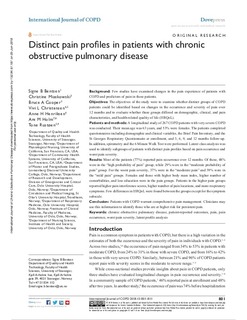| dc.contributor.author | Bentsen, Signe Berit | |
| dc.contributor.author | Miaskowski, Christine | |
| dc.contributor.author | Cooper, Bruce A. | |
| dc.contributor.author | Christensen, Vivi Lycke | |
| dc.contributor.author | Henriksen, Anne Hildur | |
| dc.contributor.author | Holm, Are Martin | |
| dc.contributor.author | Rustøen, Tone | |
| dc.date.accessioned | 2018-06-06T08:16:52Z | |
| dc.date.available | 2018-06-06T08:16:52Z | |
| dc.date.created | 2018-05-08T22:28:18Z | |
| dc.date.issued | 2018 | |
| dc.identifier.citation | The International Journal of Chronic Obstructive Pulmonary Disease. 2018, 2018 (13), 801-811. | nb_NO |
| dc.identifier.issn | 1176-9106 | |
| dc.identifier.uri | http://hdl.handle.net/11250/2500511 | |
| dc.description.abstract | Background: Few studies have examined changes in the pain experience of patients with COPD and predictors of pain in these patients.
Objectives: The objectives of the study were to examine whether distinct groups of COPD patients could be identified based on changes in the occurrence and severity of pain over 12 months and to evaluate whether these groups differed on demographic, clinical, and pain characteristics, and health-related quality of life (HRQoL).
Patients and methods: A longitudinal study of 267 COPD patients with very severe COPD was conducted. Their mean age was 63 years, and 53% were females. The patients completed questionnaires including demographic and clinical variables, the Brief Pain Inventory, and the St Georges Respiratory Questionnaire at enrollment, and 3, 6, 9, and 12 months follow-up. In addition, spirometry and the 6 Minute Walk Test were performed. Latent class analysis was used to identify subgroups of patients with distinct pain profiles based on pain occurrence and worst pain severity.
Results: Most of the patients (77%) reported pain occurrence over 12 months. Of these, 48% were in the “high probability of pain” group, while 29% were in the “moderate probability of pain” group. For the worst pain severity, 37% were in the “moderate pain” and 39% were in the “mild pain” groups. Females and those with higher body mass index, higher number of comorbidities, and less education were in the pain groups. Patients in the higher pain groups reported higher pain interference scores, higher number of pain locations, and more respiratory symptoms. Few differences in HRQoL were found between the groups except for the symptom subscale.
Conclusion: Patients with COPD warrant comprehensive pain management. Clinicians may use this information to identify those who are at higher risk for persistent pain. | nb_NO |
| dc.language.iso | eng | nb_NO |
| dc.publisher | Dove Medical Press | nb_NO |
| dc.rights | Navngivelse-Ikkekommersiell 4.0 Internasjonal | * |
| dc.rights.uri | http://creativecommons.org/licenses/by-nc/4.0/deed.no | * |
| dc.title | Distinct pain profiles in patients with chronic obstructive pulmonary disease | nb_NO |
| dc.type | Journal article | nb_NO |
| dc.type | Peer reviewed | nb_NO |
| dc.description.version | publishedVersion | nb_NO |
| dc.source.pagenumber | 801-811 | nb_NO |
| dc.source.volume | 2018 | nb_NO |
| dc.source.journal | The International Journal of Chronic Obstructive Pulmonary Disease | nb_NO |
| dc.source.issue | 13 | nb_NO |
| dc.identifier.doi | https://doi.org/10.2147/COPD.S150114 | |
| dc.identifier.cristin | 1584221 | |
| dc.description.localcode | © 2018 Bentsen et al. This work is published and licensed by Dove Medical Press Limited. The full terms of this license are available at https://www.dovepress.com/terms.php and incorporate the Creative Commons Attribution – Non Commercial (unported, v3.0) License (http://creativecommons.org/licenses/by-nc/3.0/). | nb_NO |
| cristin.unitcode | 194,65,25,0 | |
| cristin.unitname | Institutt for sirkulasjon og bildediagnostikk | |
| cristin.ispublished | true | |
| cristin.fulltext | original | |
| cristin.qualitycode | 1 | |

